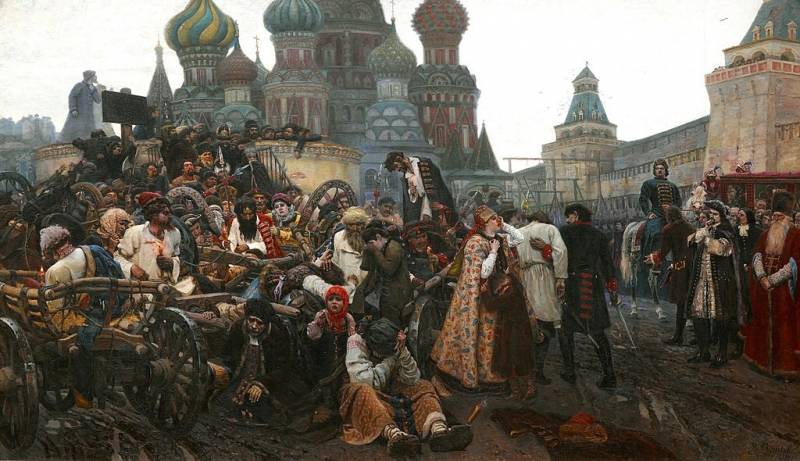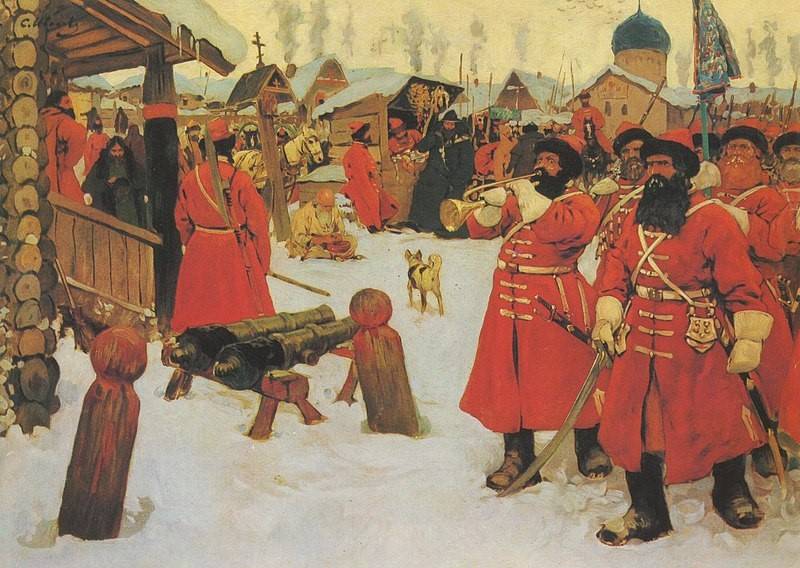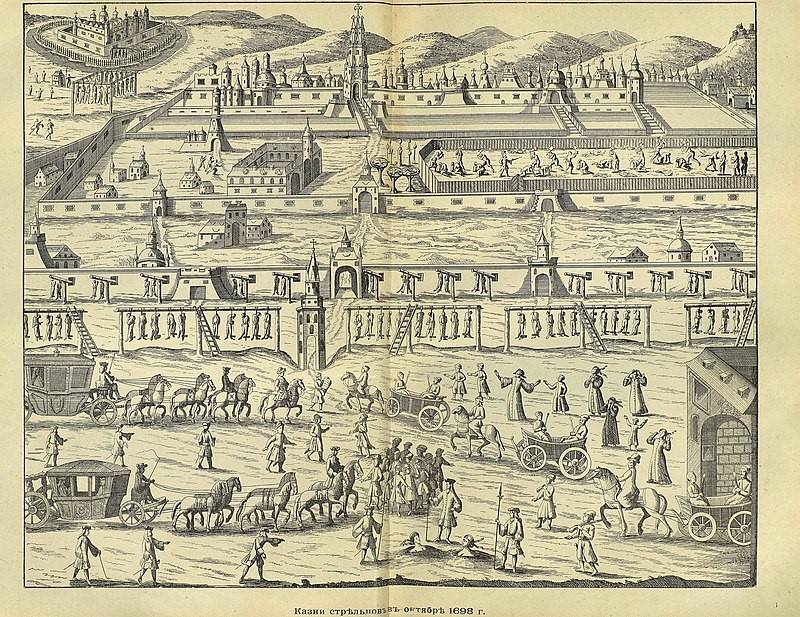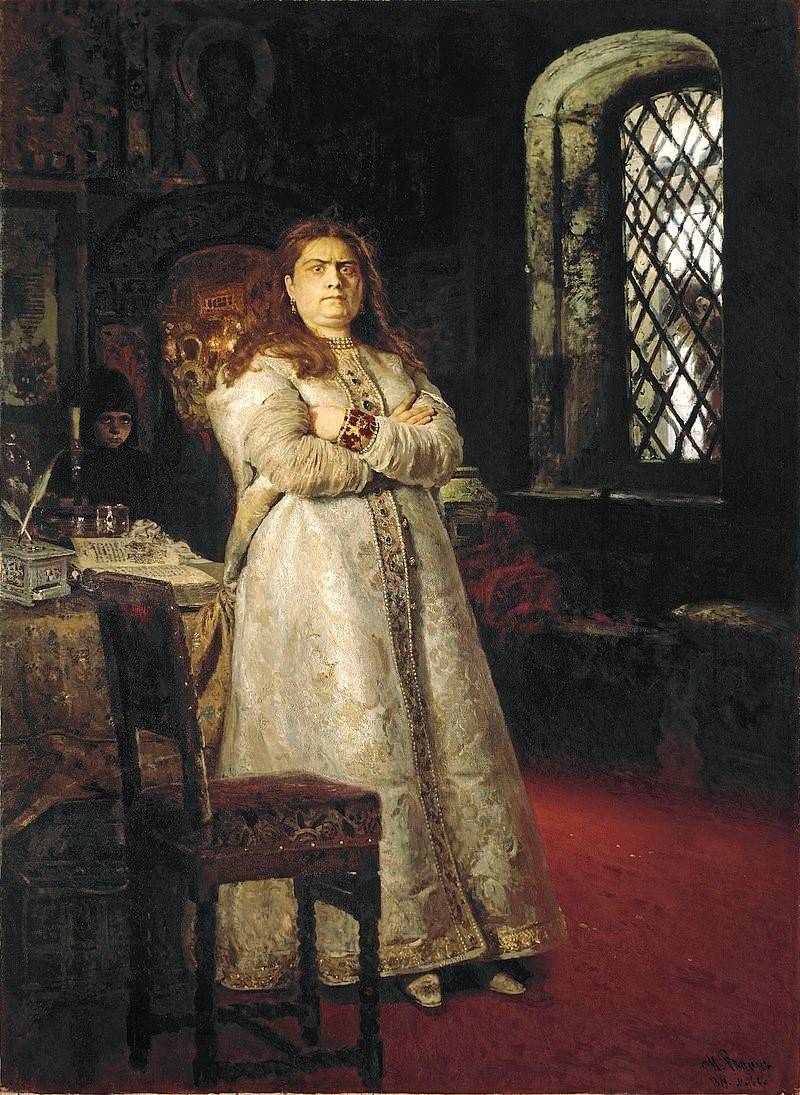Peter against archers: rebellion and executions 1698

Peter returned to Moscow when the rebellion was already suppressed. Romodanovsky conducted a superficial investigation, some archers were punished, but this investigation did not satisfy Peter, since they did not find the instigator and inspirer of the rebellion.
Revolt
And this rebellion arose like this.
After the capture of Azov, the Streltsy regiments carried out garrison service there. This was an unprecedented phenomenon, because before that the archers lived only in Moscow with their families. Then they were transferred to Velikiye Luki on the Polish border, and to Azov in their place they moved from Moscow all those archers who still remained in it. This aroused the indignation of the archers, among them a rumor spread that they would never be returned to Moscow.
When four streltsy regiments crossed to the Polish border, one and a half hundred streltsy fled the road in March 1698 and arrived in Moscow. There they heard talk about the tsar who allegedly died abroad, but more importantly, Sophia, who was in the Novodevichy Convent, through visitors, gave them a letter calling for a coup d'etat by means of a riot. The regiments moving towards Velikiye Luki soon learned about this.
They decided to support Sophia and moved towards Moscow in order to seize power. Against them, Prince Romodanovsky sent General Gordon with an army of four thousand and twenty-five guns. They met the archers at the Resurrection Monastery, and a few cannon volleys were enough for the rebels to flee. But not many managed to escape, most of them were captured and taken to Moscow.
On this rebellion ended, the investigation began.

"Archers". Painting by S. Ivanov
The whole course of the uprising was somewhat strange.
Why, for example, one and a half hundred archers lived quietly in Moscow for more than a month, although the government ordered them to return to their regiments? The fact is that rumors about the death of Peter really circulated in Moscow. The boyars were already beginning to believe in them, since there were no letters from the tsar for a long time. The fear that power would again be in the hands of Sophia made the boyars hesitate.
Finally, Romodanovsky received a reprimand from Peter from abroad:
Investigation and torture
The investigation conducted by the boyar Shein did not satisfy Peter and, upon returning, he began a new search.
In mid-September 1698, the archers, who had previously been sent to prisons and monasteries, were taken to Moscow, in total 1 people were subjected to a new investigation. Torture began in the dungeons of the Preobrazhensky Prikaz. They were tortured cruelly, knocking out testimonies. Peter himself also took part in the torture, wanting to know the name of the initiator of the rebellion.
One of the archers was tortured seven times and received 99 blows of the whip, although not all survived to the fifteenth. Lieutenant Colonel Karpakov cut his throat with a knife to end the torment, but only wounded himself, and the torture continued.
The tortured did not want to name the initiator of the rebellion. One archer was raised on a rack, received 30 blows with a whip, slowly roasted on a fire, but did not utter a word. Still, the archers had amazing stamina: they were brutally tortured, subjected to unbearable torment, but they did not give out the name of Sophia.
As for Sophia, in these terrible days for the archers, she lived a carefree and far from monastic life. She was allowed to receive visitors and write letters.
In addition, the yard gave her 10 sterlets, two pikes, two barrels of caviar, two barrels of herring, cookies, nut butter, a bucket of honey, 4 buckets of beer, all kinds of food and drinks, vodka every day. It would seem that for one person it is too much. But Sophia gathered daily crowds of visitors, she arranged noisy feasts and, most likely, did not remember the archers at all. The princess continued to be a princess in the monastery.
But back to archers.
The torture still didn't work. With the archers, Peter showed all his cruelty, for which he would later be reproached. Obviously, he not only punished them for the rebellion, but also took revenge on them for the events of 1682, when drunken crowds of archers in front of his eyes, a ten-year-old child, brutally killed his relatives and relatives. If you try to imagine the impressions of the ten-year-old Peter, then his cruelty to the archers becomes clear.
During the investigation, nevertheless, Sophia's participation in the rebellion was revealed. There were archers who betrayed her. The first of them were the five hundred Maslov and the archer Ignatiev. During interrogation, they stated that Sophia wrote letters to the archers calling for a riot. When Peter arranged a confrontation between them and Sophia, the princess, knowing that the letters had not been preserved, declared that she did not know them.
Penalties
The investigation had not yet been completed, but the executions had already begun. The first batch of archers, 201 people, were executed on 30 September. The description of the executions was made by the secretary of the Austrian embassy, Johann Georg Korb, who was then in Russia, in the Diary of a Journey to Muscovy. Korb told what he saw with his own eyes, so there is no reason not to believe him. This is how he described the first day of the executions:
Another 130 archers were brought to death from the estate of governor Shein. On both sides of all the city gates, two gallows were erected, and each was intended for six rebels that day. When everyone was taken out to the places of execution, and each six was distributed to each of the two gallows, his royal majesty in a green Polish caftan arrived, accompanied by many noble Muscovites, to the gates, where, by his decree, the tsar's ambassador stopped in his own carriage with representatives of Poland and Denmark".

Executions of shooters. Drawing from the "Diary" of Johann Korb
In October, executions of archers continued. On October 11, 144 archers were executed, on the 12th - 205, on the 13th - 141, on the 17th - 109, on the 18th - 65, on the 19th - 106 people. Peter himself acted as an executioner and cut off heads. He demanded the same from those close to him. Menshikov showed great activity here and chopped off more than twenty heads with his own hands.
Many boyars tried to keep up with him. The most awkward was Golitsyn, who could not cut off his head the first time. Because of this, his victims had to suffer. Every willing Muscovite could become an executioner, but there was no end to those who wanted to. Yes, among Muscovites there were many who hated archers.
The famous German scientist and acquaintance of Peter Leibniz, when he found out that he personally chopped off heads, expressed indignation about this.
Pyotr did not forget to punish Sophia, too, but she got off relatively lightly. 200 archers were hanged in the Novodevichy Convent, three of them hung in front of Sophia's windows for a long time, and in their hands they had petitions to her. This episode was captured in his painting by the great artist Ilya Repin. The princess herself lost her title and was tonsured a nun under the name Susanna. She died in 1704, not leaving the monastery until her death.

Painting by Ilya Repin "Princess Sofya Alekseevna in the Novodevichy Convent"
Even before the executions began on September 30, Patriarch Adrian came to Peter with an icon and began to ask for pardon for the archers. To this Peter answered him:
On October 23, the investigation and executions were suspended, since Peter left Moscow that day and went to Voronezh, where they continued to build ships. Moscow was in a state of shock from the executions. The corpses of the executed remained unburied, they still hung on the gallows, poles in the vicinity of the Kremlin were decorated with archery heads.
In some places in Moscow, the heads of archers flaunted on poles until 1727. The bodies of the unfortunate were buried in the vicinity of Moscow only in February 1699. On their graves, by order of Peter, slabs were erected with a list of all the archery crimes.
The last mass executions of archers took place on February 13, 1699 on Red Square; that day 200 archers were beheaded. During all the executions, Peter stood next to the executioner, and Menshikov was with the tsar. Most archers went to their death courageously, without even thinking to ask for mercy. Only one archer, approaching the chopping block, began to beg Peter for mercy and say that he was being executed unfairly. To this Peter answered him:
Another condemned, before going up to the chopping block, said to Peter:
From September 30 to the end of October, a total of 1 archers were executed, and on February 166, another 13 executions. Of the 200 people who were investigated, only those under the age of twenty were saved. This means that the total number of those executed and those who died from torture can be estimated at about 1 people, but no less.
16 streltsy regiments that did not participate in the rebellion were disbanded, and the streltsy with their families were deported from Moscow to other cities and recorded in townships. But soon Peter regretted such a rash decision. Already on January 20, 1699, all the former privileges were returned to the provincial archers.
The Streltsy army was revived and, as subsequent events showed, in vain. Already in 1700, the provincial archers took part in the battle of Narva and were the first, throwing weaponfleeing the battlefield. In 1702, Peter issued a decree on the recruitment of four more archery regiments. In 1705, the archers took part in the Astrakhan rebellion. Subsequently, they were gradually disbanded.
The executions of archers left their mark not only in Russian storiesbut also in painting. Repin's painting "Princess Sophia" has already been mentioned, which depicts archers hung on the windows of the princess. But the most famous painting on the theme of the executions of archers is undoubtedly Vasily Surikov's "Morning of the Streltsy Execution".

"Morning of the Streltsy Execution". V. Surikov
This picture was painted in 1881. The artist worked on it for a long time, thinking over every detail, every person. In the end, it turned out what happened. Gloomy October morning, Red Square, St. Basil's Cathedral. Crowds of archers are led to execution, their wives, mothers, and children are crying nearby. The old woman, depicted in the foreground of the picture, weeps for her son, who in a few minutes should be beheaded. Perhaps several of her sons will be executed.
But our main attention is attracted by a red-haired archer in a hat with a candle in his hand. His angry, hate-filled gaze is directed at Peter, who also clashes with his eyes. The tsar hates archers no less than they hate him. In the views of Peter and the archer, the past of Russia, which has become obsolete, and the future, personified by Peter, clashed, as it were.
One archer has already said goodbye to everyone and is preparing to lay his head on the chopping block. The blood is about to spurt and the severed head rolls. But Surikov deliberately did not show the execution process itself. It's like in a horror movie: it's not the blood itself that is scary, but the expectation of what should happen.
The morning of the Streltsy execution is the morning of October 11, 1698, when 144 people were executed. The picture depicts almost all layers of the then population of Russia: the tsar, next to him are foreigners, an elderly boyar with a long gray beard stands nearby, the convicts are led by the Preobrazhenians - the basis of the future regular army. And, finally, in the foreground is an old woman who, after the execution of her sons, has lost her meaning in life, and next to her is a little girl who probably understood what should happen to her dad.
Thus, Peter now defeated his main political opposition, those who most opposed his reforms and who hated Peter himself most of all.
It could be said that pre-Petrine Rus' also became a thing of the past with the archers, but this is not true, since not only they were its personification, but also much of what Peter was going to change in the future.
Information